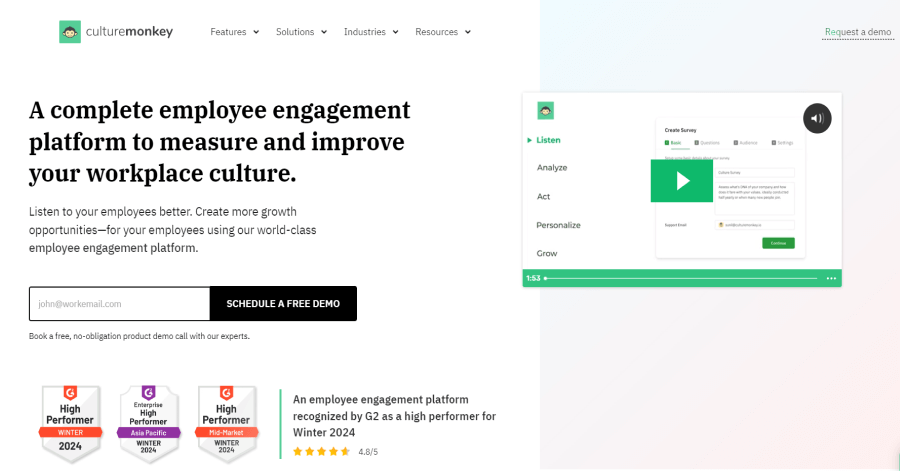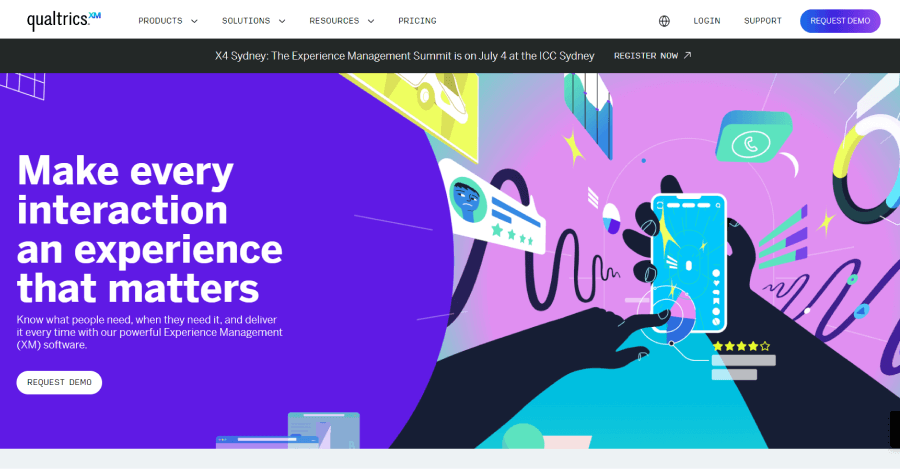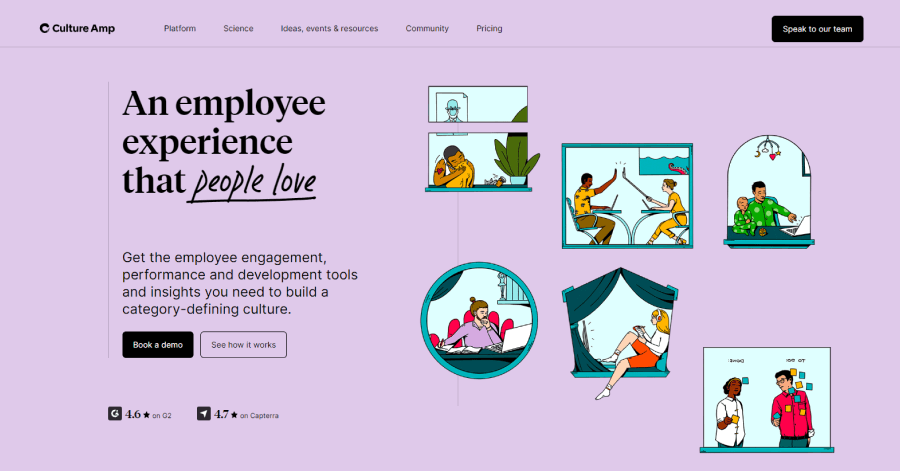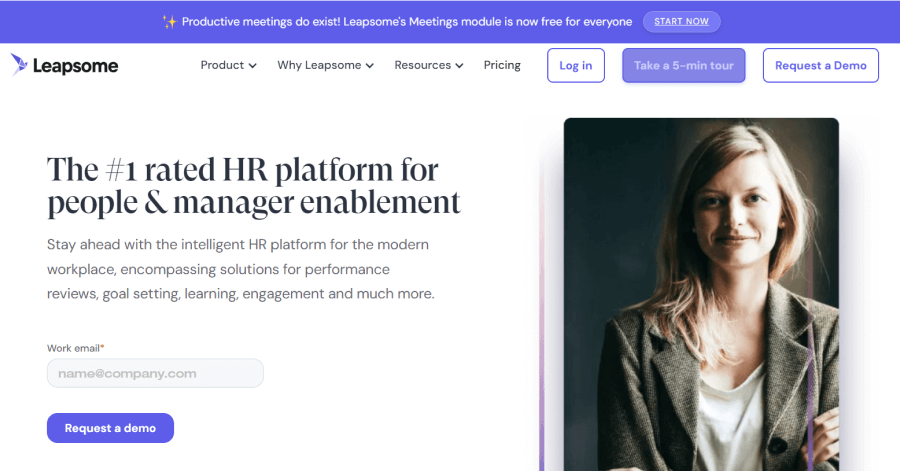75+ Employee engagement survey questions that you should ask as a leader in 2024

Everyone’s talking about the Paris 2024 Olympics!
Athletes from around the world are gearing up, aiming for gold, and pushing their limits. It’s not just about the medals; it's about the journey, the teamwork, and the sense of belonging to something bigger.
Now, imagine if we brought that same level of excitement and dedication into our workplaces. Everyone wants to feel like a gold medalist at work, right?
This is where conducting employee engagement surveys comes in. Just like athletes need feedback to improve, our employees need the right questions to thrive. Today, we're diving into the magic of employee engagement survey questions.
These aren’t just any questions; they’re the ones that can unlock the full potential of your team, creating a happier, more productive workplace. Let's explore how the right employee engagement questionnaire can turn your team into workplace champions!
Why measure employee engagement?

Employee engagement is a critical driver of organizational success. Measuring employee engagement helps businesses understand their workforce’s needs, improve job satisfaction, and drive productivity. Below are key reasons why measuring employee engagement is essential:
1. Enhances productivity
- Motivation and performance: Engaged employees are more motivated, leading to higher levels of performance and productivity. They are likely to put in extra effort and go the extra mile to achieve business objectives.
- Efficiency: Engagement metrics can highlight areas where employees excel or struggle, allowing managers to streamline processes and improve efficiency.
2. Reduces turnover
- Retention: High engagement levels are directly linked to lower turnover rates. Employees who feel valued and connected to their workplace are less likely to leave for other opportunities.
- Recruitment costs: Reducing turnover saves significant recruitment and training costs, providing a better return on investment in human resources.
3. Improves customer satisfaction
- Service quality: Engaged employees are more likely to provide better customer service, leading to increased customer satisfaction and loyalty.
- Brand ambassadors: Employees who are engaged are more enthusiastic and can positively influence the company’s brand image, both internally and externally.
4. Fosters innovation
- Creativity and ideas: Engaged employees are more likely to contribute innovative ideas and solutions. They feel empowered to think creatively and take initiative.
- Collaboration: High engagement encourages teamwork and collaboration, fostering a company culture where innovative ideas can flourish.
5. Identifies areas for improvement
- Feedback loop: Regularly measuring engagement provides a continuous feedback loop. It helps identify issues before they become significant problems and provides insights into areas needing improvement.
- Strategic planning: Data from engagement surveys can inform strategic planning and decision-making, aligning organizational goals with employee needs and expectations.
6. Enhances employee well-being
- Work-life balance: Understanding engagement levels can highlight concerns about work-life balance, stress, and burnout, enabling the organization to take proactive measures.
- Employee support: It shows a commitment to employee well-being, fostering a supportive work environment that prioritizes mental health.
What is an employee engagement survey?

An employee engagement survey is a systematic tool designed to gauge employee engagement, satisfaction, and overall sentiment of employees within an organization. This survey typically consists of a series of structured questions that cover various aspects of the work environment, including leadership effectiveness, work culture, communication channels, professional development opportunities, and overall job satisfaction.
These employee surveys serve multiple purposes. Primarily, they provide valuable insights into how employees perceive their roles and the organization as a whole. By analyzing the survey responses, management can identify strengths and weaknesses within the workplace, pinpointing specific areas that may require improvement.
For instance, if employees indicate low satisfaction with professional development opportunities, the organization can address this by enhancing training programs or offering more career advancement pathways.
Regularly conducting these surveys allows organizations to track engagement trends over time, measure the impact of implemented changes, and continuously refine strategies to enhance employee satisfaction and productivity. In essence, your next employee engagement survey is a critical tool for nurturing a motivated, productive, and loyal workforce.
Why use surveys to measure employee engagement?

Employee engagement surveys are an essential tool for understanding and improving the workplace environment. They provide a structured method for gathering insights directly from employees, enabling organizations to make informed decisions that enhance engagement, satisfaction, and overall productivity.
Here are the key reasons to use surveys to measure employee engagement:
- Direct feedback: Surveys offer a direct channel for employees to express their thoughts, feelings, and concerns about their work environment and organizational practices.
- Comprehensive data collection: They allow for the collection of comprehensive data across various departments and roles, ensuring a holistic view of employee sentiment.
- Benchmarking: Regularly conducting surveys enables organizations to benchmark engagement levels over time, helping track progress and identify trends.
- Actionable insights: The data collected provides actionable insights that can inform strategic decisions and targeted interventions to address specific issues.
- Promotes transparency: Conducting surveys promotes a culture of transparency and openness, showing employees that their opinions are valued and considered in decision-making processes.
- Enhances communication: Surveys facilitate better communication between management and employees, fostering a more inclusive and collaborative work environment.
- Supports retention strategies: By understanding the factors that contribute to employee satisfaction and dissatisfaction, organizations can develop more effective retention strategies to reduce turnover.
- Measures impact of initiatives: They allow organizations to measure the impact of implemented changes and initiatives, ensuring that efforts to improve engagement are effective and aligned with employee needs.
Understanding engagement questions vs employee feedback questions

Distinction between engagement questions and employee feedback questions is crucial for effectively gauging workplace sentiment and improving organizational performance. While both types of questions aim to collect valuable insights, their focus and application differ. Here’s a detailed comparison:
Engagement questions
- Focus on commitment: Engagement questions assess employees' emotional commitment to the organization, such as their willingness to go above and beyond their duties.
- Measure job satisfaction: These questions evaluate how satisfied employees are with their roles, responsibilities, and overall work environment.
- Gauge motivation levels: Engagement questions determine the factors that motivate employees to perform well and stay with the company.
- Assess connection to company goals: They explore how aligned employees feel with the company’s mission, vision, and goals, fostering a sense of purpose.
- Identify long-term intentions: These questions help understand employees’ intentions regarding their future with the organization, indicating potential retention issues.
Employee feedback questions
- Focus on specific experiences: Feedback questions seek detailed input on specific aspects of the workplace, such as recent projects, processes, or interactions with management.
- Identify improvement areas: They are designed to highlight areas where employees believe improvements are needed, providing actionable suggestions.
- Evaluate processes and policies: Feedback questions assess the effectiveness of current processes, policies, and systems, identifying potential bottlenecks or inefficiencies.
- Gather suggestions: These questions encourage employees to offer suggestions for enhancing the work environment, and fostering a culture of continuous improvement.
- Immediate concerns: Collecting employee feedback often addresses immediate concerns or recent changes, providing timely insights into current employee sentiment.
How to design your employee engagement survey questions?

Designing effective employee engagement survey questions is crucial for gathering meaningful insights that can drive positive organizational change. A well-crafted survey not only helps in understanding employee sentiment but also guides actionable improvements. Here are five essential steps to design your employee survey questions:
1. Define clear objectives
Start by outlining the primary objectives of the survey. Determine what specific areas you want to explore, such as job satisfaction, leadership effectiveness, or work-life balance. Clear objectives help in formulating relevant questions and ensuring that the survey addresses the most critical aspects of employee engagement.
2. Use a mix of question types
Incorporate a variety of engagement survey question types, including multiple-choice, Likert scale (rating), and open-ended questions. Multiple-choice and rating scale questions provide quantitative data, while open-ended questions allow employees to express their thoughts in detail, offering deeper insights.
3. Ensure clarity and simplicity
Craft questions that are clear, concise, and easy to understand. Avoid jargon and ambiguous terms that might confuse respondents. Simple and straightforward questions ensure that employees can respond accurately and honestly.
4. Focus on relevance
Ensure that each question is relevant to the survey's objectives and the employees' experiences. Irrelevant questions can lead to disengagement and incomplete responses. Tailor questions to reflect the specific context and culture of your organization.
5. Pilot test the survey
Conduct a pilot test with a small group of employees to identify any issues with question clarity or survey structure. Gather feedback on the survey’s length, clarity, and relevance, and make necessary adjustments before rolling it out organization-wide.
75+ Employee engagement survey questions examples

Crafting effective employee engagement survey questions across diverse topics ensures a comprehensive understanding of employee sentiment and areas for improvement. Here’s a breakdown of essential topics and questions tailored to each:
Employee engagement outcomes
1. How motivated are you to contribute to the success of the organization?
2. Do you feel your work is valued and appreciated by your team members and management?
3. How likely are you to recommend this organization as a great place to work?
4. Are you proud to work for this organization?
5. How satisfied are you with the opportunities for career growth and advancement here?
Career growth and development
6. Do you feel supported in your professional development goals?
7. Are you satisfied with the opportunities for learning and skill development provided by the organization?
8. Do you believe there are clear paths for career advancement within the company?
9. How often do you receive constructive feedback on your performance?
10. Are you satisfied with the mentoring and coaching opportunities available to you?
Communication and resources
11. How effective is communication from senior management regarding company goals and strategies?
12. Are you satisfied with the frequency and transparency of communication within your team?
13. Do you feel you have access to the resources and tools necessary to perform your job effectively?
14. How well does the organization communicate changes that affect your work?
15. Are you satisfied with the clarity of job expectations and responsibilities?
Individual needs
16. Do you feel your workload is manageable and reasonable?
17. How supported do you feel in maintaining a healthy work-life balance?
18. Are your suggestions and ideas taken into consideration by your immediate supervisor?
19. Do you feel recognized and appreciated for your contributions at work?
20. Are you satisfied with the flexibility and accommodations provided for personal needs?
Manager effectiveness
21. Does your manager provide clear direction and guidance?
22. How well does your manager support your professional growth and development?
23. Do you feel comfortable approaching your manager with concerns or problems?
24. Does your manager advocate for your team’s needs within the organization?
25. How effective is your manager in resolving conflicts within the team?
Team dynamics
26. How well does your team collaborate and work together to achieve common goals?
27. Do members of your team support each other in achieving individual and team objectives?
28. How satisfied are you with the level of teamwork and camaraderie within your team?
29. Are team meetings productive and efficient?
30. How well does your team celebrate successes and achievements?
Trust in leadership
31. How confident are you in the company's leadership?
32. Do you believe senior leadership demonstrates integrity and ethical behavior?
33. How transparent is senior leadership in their decision-making processes?
34. Are you satisfied with the direction the organization is heading under current leadership?
35. How effectively does senior leadership communicate changes and challenges facing the organization?
Future outlook
36. How optimistic are you about your future with the organization?
37. Do you believe the organization is well-positioned for future success?
38. How confident are you in the organization’s ability to adapt to industry changes?
39. Are you satisfied with the organization’s efforts to innovate and stay competitive?
40. How likely are you to stay with the organization in the next 1-3 years?
Diversity and inclusion
41. Do you feel the organization values diversity and inclusion?
42. Are you satisfied with the efforts to promote diversity within your team?
43. How inclusive do you perceive the workplace culture to be?
44. Do you believe there are equal opportunities for advancement regardless of background?
45. How comfortable are you discussing diversity-related topics at work?
Engagement survey questions
46. On a scale of 1 to 5, how motivated are you to come to work every day?
47. How satisfied are you with the recognition you receive for your accomplishments at work?
48. Do you feel your opinions are valued in decision-making processes within your team?
49. How satisfied are you with the overall work environment provided by the organization?
50. How well does the organization support your professional and personal development?
Psychological safety survey questions
51. Do you feel comfortable expressing your opinions and ideas without fear of negative consequences?
52. How often do you feel psychological safety in your interactions with colleagues?
53. Are you confident that mistakes are handled constructively and not held against you?
54. How well does your team handle disagreements and conflicts in a respectful manner?
55. Do you feel your mental health and well-being are supported by the organization?
Role and company alignment survey questions
56. How well do your current job responsibilities align with your skills and career aspirations?
57. Do you understand how your role contributes to the overall success of the organization?
58. How satisfied are you with the alignment between your personal values and the company’s mission and values?
59. Are you clear about the goals and objectives of your team and how they align with organizational goals?
60. Do you feel your role is challenging and allows you to grow professionally?
Employee wellbeing survey questions
61. How satisfied are you with the health and wellness programs offered by the organization?
62. Are you satisfied with the level of support for maintaining a healthy work-life balance?
63. How often do you feel stressed or overwhelmed at work?
64. Are you satisfied with the physical work environment (e.g., workspace, facilities)?
65. How well does the organization support your efforts to maintain overall well-being?
66. On a scale from 1 to 10, how would you rate your overall physical health and fitness?
67. How supported do you feel by your manager in balancing your work and personal life?
68. How often do you feel stressed or overwhelmed by your work responsibilities?
Likert scale employee engagement survey questions
69. Please rate your overall satisfaction with your job at this organization.
70. How satisfied are you with the opportunities for career advancement available to you?
71. Please indicate your agreement with the statement: "I feel valued and appreciated at work."
72. How well does your manager provide clear and constructive feedback on your performance?
73. Please rate your level of agreement with the statement: "I am proud to work for this organization."
74. Please indicate your agreement with the statement: "I have a clear understanding of my career path and progression within the company."
75. How well does this organization promote a culture of teamwork and collaboration?
76. Please rate your level of agreement with the statement: "I feel my work is meaningful and makes a positive impact."
What to do with employee engagement survey results?
Employee engagement survey results provide valuable insights into organizational strengths and areas for improvement. To effectively utilize this feedback and drive meaningful change, consider the following actions:
- Analyze data thoroughly: Start by analyzing survey data comprehensively, identifying key themes, trends, and areas of concern or excellence.
- Prioritize action items: Prioritize action items based on the survey findings, focusing on areas that have the greatest impact on employee engagement and satisfaction.
- Develop action plans: Collaboratively develop action plans with input from both leadership and employees to address identified issues and capitalize on strengths.
- Communicate results: Transparently communicate survey results to all employees, highlighting key findings, action plans, and timelines for implementation.
- Allocate resources: Allocate resources—whether financial, time, or personnel—to support initiatives aimed at improving employee engagement.
- Implement changes: Implement identified changes promptly and effectively, ensuring that initiatives are aligned with organizational goals and employee feedback.
- Monitor and evaluate progress: Continuously monitor the impact of implemented changes, gather ongoing feedback, and evaluate progress against initial survey benchmarks.
Top 5 employee engagement survey vendors in 2024
Choosing the right employee engagement survey vendor is crucial for obtaining accurate insights and actionable data. These vendors offer specialized tools and services to help organizations measure and enhance employee engagement effectively. Here are five reputable employee engagement survey vendors:
1. CultureMonkey

As companies strive to cultivate a positive work environment and boost employee satisfaction, the need for advanced employee engagement platforms is paramount. CultureMonkey stands out as a transformative solution in this space. Let’s explore why organizations should choose CultureMonkey for their employee engagement needs:
Goal setting and tracking
CultureMonkey supports the setting and tracking of engagement goals, a vital aspect of measuring success. With over 50+ research-backed survey templates, organizations can define, track, and analyze engagement metrics across the entire employee lifecycle, from hiring to retirement.
Inclusive and customizable surveys
In today’s diverse workforce, inclusivity is essential. CultureMonkey offers multilingual and fully customizable surveys, allowing organizations to gather feedback from employees of all backgrounds. This inclusivity ensures higher participation rates and more accurate insights.
Efficient feedback collection
CultureMonkey excels in collecting feedback from employees through widely-used channels like Email, MS Teams, Slack, WhatsApp, SMS/text messages, QR codes, and Kiosk modes. This approach ensures higher survey participation while reducing survey fatigue and provides real-time insights into employee sentiments, meeting employees where they are.
Sophisticated engagement analytics
Utilizing cutting-edge engagement analytics and the advanced capabilities of GPT technology, CultureMonkey delves deeper than basic feedback analysis. It efficiently interprets employee feedback tones, translating complex data into actionable insights that drive significant organizational change.
Lifecycle feedback mechanism
Employee engagement is an ongoing process. CultureMonkey’s employee lifecycle module ensures continuous feedback collection from onboarding to separation. This continuous listening helps organizations address issues proactively and improve retention efforts.
Real-time pulse surveys
CultureMonkey’s pulse surveys allow organizations to gather frequent, real-time feedback, capturing the dynamic nature of employee sentiments. This real-time data helps leaders identify emerging trends and take timely corrective actions to maintain a positive work environment.
Comprehensive engagement metrics
CultureMonkey goes beyond traditional metrics, evaluating over 15 engagement drivers including work-life balance, mental health, e-NPS (employee net promoter score), and leadership effectiveness. This comprehensive approach helps organizations pinpoint areas for improvement and implement targeted interventions.
Rapid feedback processing
In today’s fast-paced business environment, timely insights are crucial. CultureMonkey uses GPT technology to process thousands of feedback responses swiftly, providing understandable analytics in minutes. This speed enables organizations to quickly identify trends and prioritize actions.
Commitment to privacy and security
CultureMonkey prioritizes employee privacy and data security, ensuring GDPR compliance and anonymous feedback collection. This commitment to privacy builds trust among employees and guarantees the confidentiality of their responses.
Seamless integration
CultureMonkey integrates seamlessly with various business tools and HRMS platforms such as Workday, Darwin Box, Zoho People Microsoft Dynamics 365, and more. This integration streamlines data management processes and enhances overall efficiency and user experience.
Personalized support
CultureMonkey offers exceptional customer support beyond implementation. Their Customer Success team delivers personalized engagement insights and guides organizations in optimizing their employee engagement strategies, ensuring swift adoption and immediate impact.
2. Qualtrics

Comprehensive engagement solutions
Qualtrics offers a platform that covers the entire employee lifecycle, from onboarding to exit interviews. This holistic approach ensures continuous feedback and insights into every stage of the employee experience, helping companies to make informed decisions that enhance overall engagement.
Advanced analytics and reporting
With Qualtrics, organizations can easily identify trends, measure engagement metrics, and understand the key drivers of employee satisfaction. This data-driven approach enables targeted interventions that can significantly improve workplace morale and productivity.
Customizable survey tools
Qualtrics provides highly customizable survey tools that allow businesses to tailor their feedback mechanisms to specific needs. This flexibility ensures that surveys are relevant and engaging for employees, leading to higher response rates and more accurate insights into employee sentiments.
Integration and scalability
Designed to seamlessly integrate with existing HR systems, Qualtrics ensures smooth data flow and enhanced efficiency. Its scalable solutions cater to organizations of all sizes, making it a versatile choice for businesses looking to grow and adapt their employee engagement strategies over time.
3. Culture Amp

Comprehensive surveys
Culture Amp offers a wide range of survey tools, from engagement to onboarding and exit surveys. These surveys provide deep insights into employee experiences and help identify key areas for improvement.
Data-driven insights
With advanced analytics, Culture Amp translates survey data into actionable insights. The platform uses data science to help organizations understand the factors driving employee engagement and inform strategic decisions.
Customizable and inclusive
Culture Amp’s surveys are fully customizable and available in multiple languages, ensuring they cater to diverse workforces. This inclusivity promotes higher participation rates and more accurate feedback.
Continuous development
The platform supports continuous employee development with personalized growth plans and valuable L&D data. This helps in nurturing talent and enhancing employee retention
4. Leapsome

Holistic engagement surveys
Leapsome provides comprehensive engagement surveys that offer actionable insights into employee sentiments. These surveys are designed to identify strengths and areas for improvement, facilitating a deeper understanding of workplace dynamics.
Advanced analytics
With Leapsome's analytics, companies can transform raw data into meaningful insights. The platform’s data-driven approach helps organizations make informed decisions to enhance employee satisfaction and performance.
Customization and inclusivity
Leapsome’s surveys are fully customizable and available in multiple languages, ensuring they cater to diverse employee needs. This feature promotes higher participation rates and more accurate feedback, capturing the true voice of the workforce.
Continuous feedback and development
Leapsome emphasizes continuous feedback throughout the employee lifecycle. Its tools support ongoing development and engagement, ensuring employees feel valued and heard at every stage of their journey within the company.
5. Lattice

Engagement surveys
Lattice provides detailed engagement surveys that capture employee sentiments effectively. These surveys help identify areas of improvement and strengths, fostering a deeper understanding of the organizational climate.
Advanced analytics
With Lattice’s advanced analytics, companies can transform survey data into actionable insights. The platform’s robust analytical tools enable data-driven decisions to enhance employee satisfaction and performance.
Customizable and inclusive
Lattice offers fully customizable surveys and tools available in multiple languages, ensuring inclusivity. This feature promotes higher participation and more accurate feedback, capturing the true voice of the workforce.
Continuous feedback mechanisms
Lattice emphasizes continuous feedback throughout the employee lifecycle. Its tools support ongoing development and engagement, ensuring employees feel valued and heard at every stage of their journey within the company.
Conclusion
Crafting the right employee engagement survey questions is pivotal to understanding and improving workplace dynamics. By carefully selecting and tailoring your employee engagement questions, you can uncover valuable insights into employee sentiments and drive meaningful change.
When it comes to choosing the best employee engagement platform for this task, CultureMonkey stands out. Its comprehensive, customizable, and data-driven approach ensures that every voice is heard and acted upon.
CultureMonkey not only facilitates effective feedback collection but also provides advanced analytics and continuous development tools, making it the ultimate choice for fostering a thriving organizational culture.



